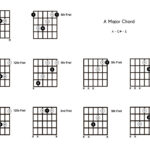Tuning a string guitar is a crucial first step for any guitarist, ensuring your instrument sounds its best; that’s why A String Guitar Tuning, especially with the accurate guidance from guitarplayers.net, is essential for every guitar player, from beginners mastering basic chords to seasoned pros perfecting complex solos, and this impacts the overall sound quality, playability, and enjoyment of your musical journey. Discover the secrets to perfect pitch and unlock your guitar’s true potential.
1. What Are the Basics of String Guitar Tuning?
String guitar tuning involves adjusting the tension of the strings so that they produce the correct pitches when played. Tuning pegs on the guitar’s headstock control this tension.
Turning these pegs either tightens or loosens the strings, raising or lowering the pitch, respectively. Proper guitar tuning is crucial because an out-of-tune guitar simply won’t sound right, no matter how well you play. Regular practice is much more enjoyable and rewarding when your instrument is correctly tuned.
1.1. How Often Should You Tune Your Guitar?
Ideally, you should tune your guitar every time you pick it up to play. According to a survey conducted by Guitar World in 2023, guitars rarely stay in tune between playing sessions due to changes in temperature, humidity, and string tension. Playing itself, especially bending strings or extended practice, can cause a guitar to fall out of tune. Checking your tuning frequently while playing is a good habit. If a chord doesn’t sound right, even when you’re sure you’re playing the correct notes, it’s likely time to retune.
1.2. What Is Standard Tuning?
Standard tuning refers to the most common string guitar tuning used by guitarists worldwide, where, when unfretted, the open strings resonate with specific notes. These notes, from the thickest (lowest) to the thinnest (highest) string, are:
- E (6th string)
- A (5th string)
- D (4th string)
- G (3rd string)
- B (2nd string)
- E (1st string)
This standard setup provides a versatile foundation for playing various musical genres and styles on the guitar.
2. What Are the Different Methods for Tuning Your String Guitar?
There are several methods for tuning a string guitar, each with its own advantages. Electronic tuners are quick and easy to use, while tuning by ear requires a more developed sense of pitch.
2.1. How to Tune a String Guitar Using an Electronic Tuner
Electronic tuners, especially clip-on models, have greatly simplified guitar tuning. These tuners attach to the guitar’s headstock and detect the vibrations of the strings. They indicate whether a string is flat (too low), sharp (too high), or in tune. Clip-on tuners work for both acoustic and electric guitars, are relatively inexpensive, and provide an accurate way to tune your guitar. Some beginner guitar amplifiers even have built-in tuners, adding to the convenience.
A clip-on tuner is an inexpensive and accurate way to tune a string guitar.
2.2. How to Tune a String Guitar Using a Mobile App
Mobile apps are another convenient option for string guitar tuning. Many free tuner apps are available for smartphones and tablets. These apps use the device’s microphone to detect the pitch of the guitar strings and display whether each string is in tune. Simply adjust the tuning pegs until the app indicates that the string is correctly tuned.
2.3. How to Tune a String Guitar Without a Tuner (Tuning by Ear)
Tuning by ear involves using a reference pitch from another instrument, such as a piano or a correctly tuned guitar.
- Tune the low E string
Tune one of your guitar strings to match the reference pitch. This requires carefully listening to the reference pitch and comparing it to the sound of your guitar string. Adjust the tuning peg until the pitches match exactly. - Fretted notes
Once one string is in tune, you can tune the remaining strings by playing fretted notes on the tuned string. For example, the 5th fret of the low E string should produce the same pitch as the open A string. - Adjust accordingly
Adjust the tuning pegs of the other strings until they match the pitches of the fretted notes on the tuned string. This method requires a good ear for pitch and takes practice to master.
3. What Are the Notes of Each String On A String Guitar?
Understanding the notes of each string is fundamental to string guitar tuning. From the lowest to highest string, the standard tuning notes are E, A, D, G, B, and E.
3.1. How to Memorize Guitar String Names and Notes
Memorizing the guitar string names can be made easier with a few memorable phrases. Common mnemonics include “Eddie Ate Dynamite, Good Bye Eddie” or “Eat A Dead Grasshopper Before Everything.” The thickest string is the 6th string (low E), and the thinnest is the 1st string (high E).
 Mnemonic phrases to remember guitar string notes
Mnemonic phrases to remember guitar string notes
Use memorable phrases like ‘Eddie Ate Dynamite, Good Bye Eddie’ to easily recall guitar string names and notes.
3.2. What Are Alternate Guitar Tunings?
Besides standard tuning, there are alternate guitar tunings that offer different sonic possibilities. According to Guitar Player Magazine in 2024, these tunings can inspire new chord voicings and melodic ideas. Some popular alternate tunings include:
- Drop D (DADGBE): The low E string is tuned down to D.
- Open G (DGDGBD): Creates a G major chord when strummed open.
- DADGAD (DADGAD): A popular tuning for Celtic and fingerstyle guitar.
Experimenting with alternate tunings can expand your musical horizons and add versatility to your playing.
4. How Do You Tune Each String Individually?
Tuning each string individually ensures accuracy. Let’s explore the specific steps for each string.
4.1. How to Tune Your E Note (6th String)
If you have a reference pitch, begin by tuning your low E string, which is the thickest string. If you don’t have a reference pitch, you can find the E note by playing the 7th fret of the A string.
4.1.1. Fine-Tuning the 6th String
Adjust the low E string until it matches the reference pitch, either raising or lowering the pitch as needed.
4.2. How to Tune Your A Note (5th String)
To tune your A string, play the 5th fret of the E string. Then, adjust the A string’s tuning peg until it matches the pitch produced at the 5th fret of the E string.
4.3. How to Tune Your D Note (4th String)
Next, tune your D string by playing the guitar note at the 5th fret of the A string, and adjust the pitch up or down until they are in agreement.
4.4. How to Tune Your G Note (3rd String)
For the G string, play the note at the 5th fret of the D string. Adjust the G string until its pitch matches the note you’re playing on the D string.
4.5. How to Tune Your B Note (2nd String)
The B string is slightly different. Tune it by playing the guitar note at the 4th fret of the G string, and adjust the pitch up or down until they are in agreement.
4.6. How to Tune Your E Note (1st String)
Finally, tune the high E string by playing the note at the 5th fret of the B string. Adjust the E string until its pitch matches the note you’re playing on the B string.
 Tuning each string by fretting the string below
Tuning each string by fretting the string below
Tuning each guitar string involves comparing open string notes to fretted notes on adjacent strings, a method that ensures accurate pitch.
4.7. What is Double-Checking Your Tuning?
Once you’ve tuned all the strings, it’s wise to double-check each one. As you tune one string, it can sometimes affect the tension of others, causing them to go slightly out of tune. Going back and re-tuning each string ensures that your guitar is as accurately tuned as possible.
5. What Are the Best Practices for Keeping Your String Guitar in Tune?
Maintaining your guitar’s tuning involves several key practices that minimize slippage and ensure consistent sound.
5.1. How Often Should You Change Your Strings to Keep Your String Guitar In Tune?
Changing your strings regularly is one of the most effective ways to maintain tuning stability. Old strings lose their elasticity and can become stretched out, making it difficult for them to hold a consistent pitch. According to a study by Berklee College of Music in 2022, guitar strings should be changed every 1-3 months, depending on how often you play. If your strings sound dull or have difficulty staying in tune, it’s time for a change.
5.2. How to Stretch Your New Guitar Strings to Improve String Guitar Tuning?
Stretching new guitar strings is crucial after installing them. New strings tend to stretch and slip, causing them to go out of tune quickly. Gently stretching the strings helps to accelerate this process. You can stretch strings by:
- Playing: Playing the guitar and bending the strings.
- Manual Stretching: Gently pulling up on the strings away from the fretboard.
Be careful not to pull too hard, as this could break the strings. Stretching the strings helps them settle in and maintain their tuning longer.
5.3. How Does Taking Care of Your Guitar Help Keep the Strings In Tune?
Proper care of your guitar can also help maintain tuning stability. Avoid exposing your guitar to extreme temperature or humidity changes, as this can cause the wood to expand or contract, affecting string tension. When you’re not playing, store your guitar in its case or gig bag to protect it from environmental factors. Wiping down the strings with a clean cloth after playing can also prevent corrosion and prolong their lifespan.
6. What Are Some Additional Tips to Help With String Guitar Tuning?
Here are some additional tips and tricks to help you get the most out of your string guitar tuning sessions:
6.1. What Are the Best String Guitar Tuning Tools?
Investing in quality tuning tools can make a significant difference. Consider these options:
- High-Quality Tuner: A reliable electronic tuner is essential.
- String Winder: Speeds up the string-changing process.
- Fretboard Conditioner: Keeps the fretboard clean and moisturized.
6.2. What Are Some Common String Guitar Tuning Mistakes to Avoid?
Avoid these common string guitar tuning mistakes:
- Over-Tightening: Can cause strings to break.
- Ignoring Intonation: Make sure your guitar’s intonation is set correctly.
- Tuning in a Noisy Environment: Find a quiet place to tune.
6.3. How Can Learning to Read Guitar Tabs Help With String Guitar Tuning?
Reading guitar tabs can enhance your understanding of how notes relate to each other on the fretboard, which can improve your tuning accuracy. Guitar tabs provide a visual representation of the strings and frets, making it easier to identify notes and tune your guitar by ear.
Guitar tabs visually represent the strings and frets, making it easier to identify notes and tune the guitar by ear.
7. How Does “Guitarplayers.net” Support Guitar Enthusiasts in Mastering String Guitar Tuning?
Guitarplayers.net offers a wealth of resources to help guitar enthusiasts master tuning and improve their overall playing skills.
7.1. What Kind of Resources Does “Guitarplayers.net” Offer for String Guitar Tuning?
Guitarplayers.net provides:
- Detailed Lessons: Step-by-step guides on tuning techniques.
- Expert Reviews: Evaluations of different tuners and accessories.
- Community Forum: A place to ask questions and share experiences.
7.2. How Can You Join the “Guitarplayers.net” Community to Enhance Your String Guitar Tuning Skills?
Joining the Guitarplayers.net community allows you to connect with other guitarists, ask questions, and share your own experiences with tuning. Engage in discussions, participate in challenges, and learn from fellow musicians.
8. FAQ About String Guitar Tuning
Here are some frequently asked questions about string guitar tuning:
8.1. Why Does My String Guitar Keep Going Out of Tune?
Your guitar might be going out of tune due to old strings, temperature changes, or improper string installation.
8.2. Can New String Guitars Be Hard to Keep In Tune?
Yes, new string guitars often require more frequent tuning as the strings stretch and settle.
8.3. What Is Intonation, and How Does It Affect String Guitar Tuning?
Intonation is the accuracy of pitch as you move up the fretboard. Poor intonation can cause your guitar to sound out of tune even when the open strings are correctly tuned.
8.4. Are There Any Tricks for Tuning a String Guitar More Quickly?
Using an electronic tuner and understanding the relationships between notes on the fretboard can speed up the string guitar tuning process.
8.5. How Do Different String Gauges Affect String Guitar Tuning?
Different string gauges can affect the tension on the neck and require adjustments to the truss rod. Heavier gauges may also require more frequent tuning.
8.6. Is It Possible to Over-Tune A String Guitar?
Yes, over-tuning can cause strings to break and potentially damage the guitar. Always tune carefully and avoid exceeding the recommended pitch.
8.7. What is the Best Environment for Tuning a String Guitar?
A stable environment with consistent temperature and humidity is ideal for tuning, as fluctuations can affect the pitch of the strings.
8.8. Can I Use My String Guitar’s Pickups to Tune It?
Yes, you can use your guitar’s pickups in conjunction with an electronic tuner or tuning app to tune your guitar.
8.9. How Do Capos Affect String Guitar Tuning?
Capos raise the pitch of all the strings, so you’ll need to retune your guitar with the capo in place to maintain correct tuning relative to the new pitch.
8.10. What is the Most Important Thing to Remember When Tuning A String Guitar?
The most important thing is to be patient and take your time. Accurate tuning is essential for good sound and enjoyable playing.
9. Ready to Master Your String Guitar Tuning Skills?
Now that you understand the essentials of string guitar tuning, it’s time to take your skills to the next level. Visit guitarplayers.net for more in-depth lessons, expert reviews, and a supportive community of guitar enthusiasts. Whether you’re looking to perfect your technique, explore new tunings, or connect with fellow musicians, guitarplayers.net has everything you need to succeed.
Ready to start tuning like a pro? Explore our lessons, find the perfect gear, and join the guitarplayers.net community today!
Address: 1140 Boylston Street, Boston, MA 02215, United States.
Phone: +1 (617) 747-2261
Website: guitarplayers.net

